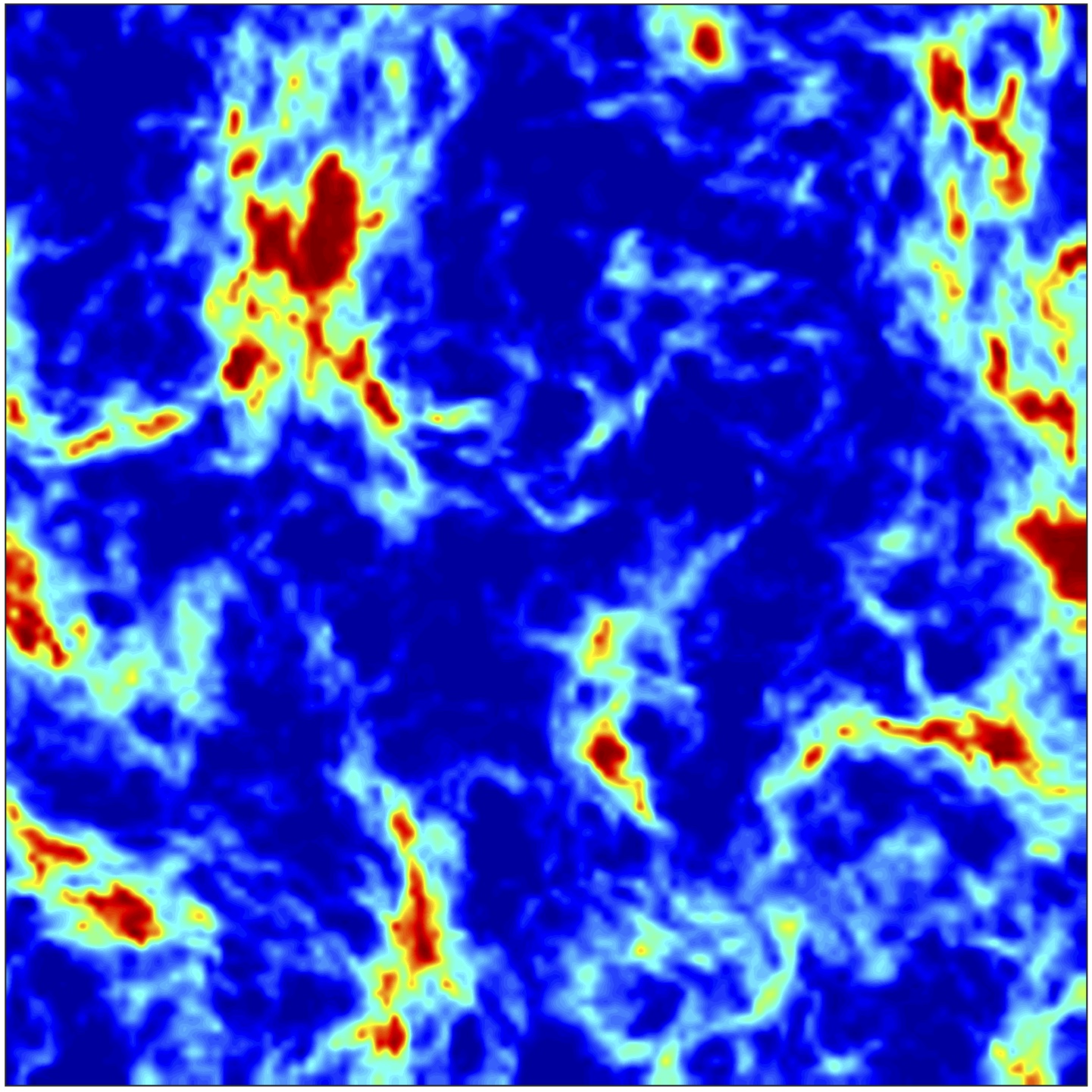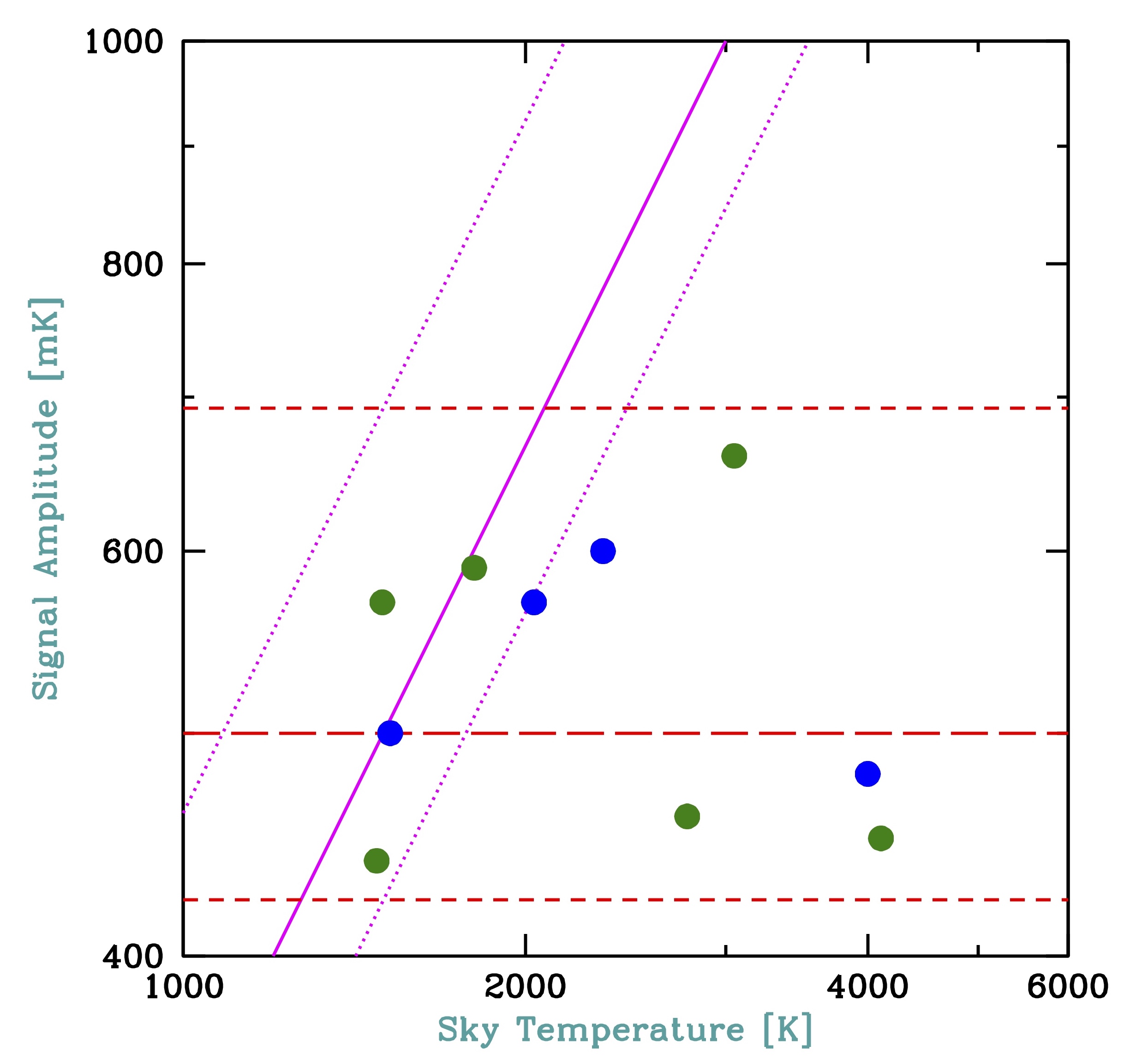Nature, advance online publication on Wednesday, Feb. 28'th 2018 (in print Thursday, Mar. 1'st).
This webpage contains a short non-technical outline, selected links to audio/video
and other websites, and a technical note about the EDGES measurement.
![]()

|
| An example of the predicted radio wave pattern on the sky due to the effect of dark matter in the early Universe. |
In recent decades, many of the biggest discoveries in physics have come from astronomy (dark matter, dark energy, gravitational waves, and black holes). This includes major progress on what makes up the Universe. For millenia, people speculated that stars are made of an exotic, cosmic substance. Then, in the 19'th century physicists discovered that light carries fingerprints of the atoms that emitted the light. Thus, it was discovered that the Sun and other stars are composed of the same kinds of chemical elements as are known to us on Earth. Starting in the 1970's, astronomers increasingly came to realize that most of the matter in the Universe is actually different from this "ordinary" matter that we know. The rotation of galaxies including our own Milky Way is so rapid that, according to Newton's theory of gravity (as generalized by Einstein), the strong gravity that causes this motion must come from a mass that is much larger than what we see in stars and gas. This mass is invisible (neither emits nor blocks light), so it is known as "dark matter". That there is five times more dark matter than ordinary matter is confirmed by observations of the remant glow of the early Universe.
Today the Universe is expanding, and it cools as it expands. If we look back in time, before the Universe had expanded so much, it was much hotter and denser. At an early time, conditions throughout the Universe were similar to the physical conditions in the Sun today, and the whole Universe glowed with light. This light still fills the Universe, but due to the cosmic expansion, it has been transformed into radio waves known as the Cosmic Microwave Background (CMB).
Now, astronomers explore our distant past, billions of years back in time. Unlike archaeologists on Earth, however, who can only study remnants of the past, astronomers can see the past directly. It takes the light from distant objects a long time to reach us, and we see these objects as they were back when they emitted their light. For example, we see our own Sun not as it is now, but as it was 8 minutes ago. Other stars in the sky we see from many years ago. If astronomers look out far enough, they can see the first stars as they actually were in the early Universe.
For over a decade, astronomers have been searching for a radio-wave signal that had been predicted to be a sign of the formation of the first stars. The idea was that when the first stars formed, their radiation changed the internal state of the hydrogen atoms that filled the Universe. This should cause the hydrogen to absorb some of the radio waves of the CMB. Radio astronomers should thus be able to detect when the first stars formed by detecting this absorption. The point is that this occurred so early, and the corresponding signal is so distant, that we cannot see those first stars in any other way. Note that this field is called "21-cm cosmology" since the hydrogen atoms absorb radio waves at a wavelength of 21 centimeter.
The EDGES observation and my dramatic interpretation were announced in March 2018, and reported in two separate papers in Nature. If true, this exciting discovery will have enormous implications, and represent another example of deriving fundamental physics from astronomical observations. Indeed, this is the first direct clue about the nature of the mysterious dark matter that makes up most of the matter in the Universe. For example, physicists expected that dark matter would be made up of heavy particles, but the discovery indicates low-mass particles. This insight alone has the potential to reorient the search for dark matter.
Some caution is needed, since the EDGES measurement is the first of
its kind. Independent confirmation is now being attempted, and much
more information is expected within a few years. I predict that the
dark matter produced a specific pattern of radio waves on the sky (see
the image), which can be detected with a large array of radio
antennas. One such array is the SKA (Square Kilometre Array), the
largest radio telescope in the world, now under construction. Such an
observation with the SKA would confirm that the first stars have
indeed revealed the dark matter. While the SKA may directly measure
the predicted radio images on the sky, other radio arrays such as HERA
may first achieve a statistical detection of the expected pattern.
![]()

|
|
The best-fit amplitude of the
21-cm absorption signal versus the intensity of the sky (i.e.,
the foreground). The blue and green points are based on the
same data, but with different binning in time and using
different foreground models. Red curves show the best-fit
amplitude (long-dashed curve) for the best data (i.e., the
data taken when the sky temperature was lowest), along with
the one-sigma error range (short-dashed curves). The magenta
solid curve (plus dotted curves for the one-sigma range) shows
the expected signal amplitude if it were proportional to the
foreground level. Points taken from Extended Data Table 2 in
the EDGES paper [Nature 555, 67 (2018)].
|
The figure (above or to the left) shows how the signal amplitude varies with the foreground level. The measurements all lie close to the amplitude derived from the best data (i.e., within the range indicated by the horizontal red curves). These measurements are completely inconsistent with being proportional to the foreground level (in which case they would all lie within the band indicated by the rising magenta curves).
One possibility to evade this test is to have the apparent 21-cm
signal produced by an extragalactic foreground that does not vary
strongly with position on the sky. However, radio emission at such low
frequencies is thought to come from synchrotron emission, which is
spectrally smooth even when coming from a single electron. The
spectrum should be further smoothed by the superposition of the large
number of synchrotron sources that contribute to the global (sky
averaged) 21-cm signal. I am not aware of a published claim that
synchrotron sources can produce as sharp a frequency structure as that
measured by EDGES.
![]()